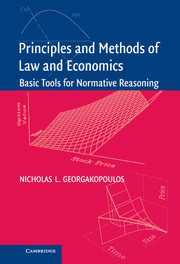Book contents
- Frontmatter
- Contents
- Preface
- INTRODUCTION: INNOVATION IN LEGAL THINKING
- PART 1 PRINCIPLES
- PART 2 METHODS
- 7 MATHEMATICAL MODELING
- 8 CONFRONTING UNCERTAINTY: BASIC PROBABILITY THEORY
- 9 ADVANCED PROBABILITY: DISTRIBUTIONS AS THE SHAPE OF RANDOMNESS
- 10 HOW TO PRICE UNCERTAINTY: FINANCE
- 11 FINANCE AND PROBABILITY: OPTIONS AND DERIVATIVES
- 12 USING SPREADSHEETS
- 13 STATISTICS
- 14 CONCLUSION: IMPORTING METHODOLOGICAL INNOVATIONS
- APPENDIX A MEINHARD V. SALMON 249 N.Y. 458 (1928)
- APPENDIX B GLOSSARY
- APPENDIX C MATHEMATICA NOTEBOOKS
- Index
9 - ADVANCED PROBABILITY: DISTRIBUTIONS AS THE SHAPE OF RANDOMNESS
Published online by Cambridge University Press: 24 July 2009
- Frontmatter
- Contents
- Preface
- INTRODUCTION: INNOVATION IN LEGAL THINKING
- PART 1 PRINCIPLES
- PART 2 METHODS
- 7 MATHEMATICAL MODELING
- 8 CONFRONTING UNCERTAINTY: BASIC PROBABILITY THEORY
- 9 ADVANCED PROBABILITY: DISTRIBUTIONS AS THE SHAPE OF RANDOMNESS
- 10 HOW TO PRICE UNCERTAINTY: FINANCE
- 11 FINANCE AND PROBABILITY: OPTIONS AND DERIVATIVES
- 12 USING SPREADSHEETS
- 13 STATISTICS
- 14 CONCLUSION: IMPORTING METHODOLOGICAL INNOVATIONS
- APPENDIX A MEINHARD V. SALMON 249 N.Y. 458 (1928)
- APPENDIX B GLOSSARY
- APPENDIX C MATHEMATICA NOTEBOOKS
- Index
Summary
Complex as the analysis of Chapter 8 may seem, it did contain an extraordinary simplification. Each source of uncertainty had a limited number of possible outcomes; one outcome typically corresponded to each alternative. When revisiting the facts of Meinhard v. Salmon with an eye on probable alternatives (see exercise 8.1), we considered the possibility that its Fifth Avenue location would change character. The building was assumed to have a single value if Fifth Avenue maintained its luster. A more realistic outlook would concede that the value of the expansion might take any one of a range of values.
When uncertainty is about amounts or sizes rather than whether an event occurs, the simple concepts of probability that were introduced in Chapter 8 are inadequate. The alternatives may be infinite and cannot fit in tables or probability trees. However, a concept of probability theory manages to impose order. This concept is the distribution function. The contrast with the probabilities of alternative outcomes (on which Chapter 8 focused) reveals that distribution functions are a step toward generality. Rather than identify the alternatives, a model can use a distribution function that allows any outcome from a specified range that may extend to infinity.
Continuous distributions are at the extreme end of the range of sophistication in probability theory discussed here. The previous chapter started with simple tables. The transition from the table to the probability tree continues with discrete distributions and culminates with continuous distributions.
Information
- Type
- Chapter
- Information
- Principles and Methods of Law and EconomicsEnhancing Normative Analysis, pp. 175 - 196Publisher: Cambridge University PressPrint publication year: 2005
